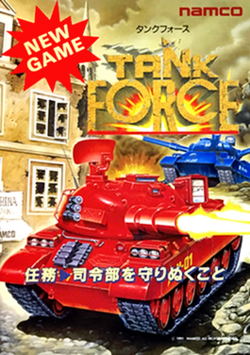Tank Force
Topic: Software
 From HandWiki - Reading time: 2 min
From HandWiki - Reading time: 2 min
| Tank Force | |
|---|---|
 Advertising flyer | |
| Developer(s) | Namco |
| Publisher(s) | Namco |
| Series | Tank Battalion |
| Platform(s) | Arcade |
| Release |
|
| Genre(s) | Multi-directional shooter |
| Mode(s) | Single-player, multiplayer |
Lua error in Module:Lang/utilities at line 332: attempt to call field '_transl' (a nil value). is a 1991 multi-directional shooter arcade game developed and published in Japan by Namco. It was designed by Yutaka Kounoe, whose works include Dig Dug, Lucky & Wild, and Point Blank.[1][2] The game is a successor installment to Namco's Battle City (1985), itself a successor to Tank Battalion (1980). In 2017, the two-player version was re-released for the Nintendo Switch as part of the Namco Museum compilation.
Gameplay
The gameplay is very much like that of Tank Battalion, except that this time up to two (on an upright model) or four (on a cocktail) players can play simultaneously, there are seven new types of enemy tanks (Normal Tanks, Speed Tanks, Hard Tanks, Big Tanks, Rapid Tanks, Tomahawk Tanks and Jeeps) and there is fifteen types of powerups (Bonus 500, 1000, 2000 and 3000, Shot Powerup, 4-Way Shot, Hyper Shot, Ripple Laser, Twin Shot, Small, Shield, Bomb Attack, Timer Stop, Force Field and Extend) which appear for players to collect in order to increase their tanks' firepower and boost their score; the enemies also roll into view from the top of the screen instead of just appearing and can also enter from the left and right sides, every fourth round is a "boss" round where the players must fight Train Cannons, AK Tanks and Boss Cannons at the top of the screen as well as the round's regular enemies, the players cannot destroy their own headquarters walls, when one player shoots another they will be pushed back, and the game has an ending which will be seen after clearing all thirty-six rounds.
Reception
Game Machine reported that Tank Force was the fourth most-popular arcade game of February 1992.[3]
In his review for Namco Museum on the Nintendo Switch, Damien McFerran of Nintendo Life said that Tank Force made for an odd inclusion due to its obscurity, describing it as "Pac-Man with tanks and destructible environments".[4]
Notes
References
- ↑ Tilley, Sorrel (April 2012). "The Making Of: Lucky & Wild". Retro Gamer. United Kingdom: Imagine Publishing. pp. 36–39. https://archive.org/details/RetroGamerIssue101-102/page/n35/mode/2up. Retrieved 7 March 2020.
- ↑ Tilley, Sorrel (8 November 2012). "The Making Of: Point Blank". Retro Gamer. United Kingdom: Imagine Publishing. pp. 38–39. https://archive.org/stream/retro_gamer/RetroGamer_109#page/n37/mode/2up. Retrieved 23 December 2019.
- ↑ "Game Machine's Best Hit Games 25 - テーブル型TVゲーム機 (Table Videos)". Game Machine (Amusement Press) (419): 25. 1 February 1992.
- ↑ McFerran, Damien (28 July 2017). "Namco Museum Review (Switch eShop)". Gamer Network. Archived from the original on 1 September 2019. https://web.archive.org/web/20190901043304/http://www.nintendolife.com/reviews/switch-eshop/namco_museum. Retrieved 1 May 2020.
External links
 |
20 views | Status: cached on April 13 2025 06:58:15
↧ Download this article as ZWI file
 KSF
KSF